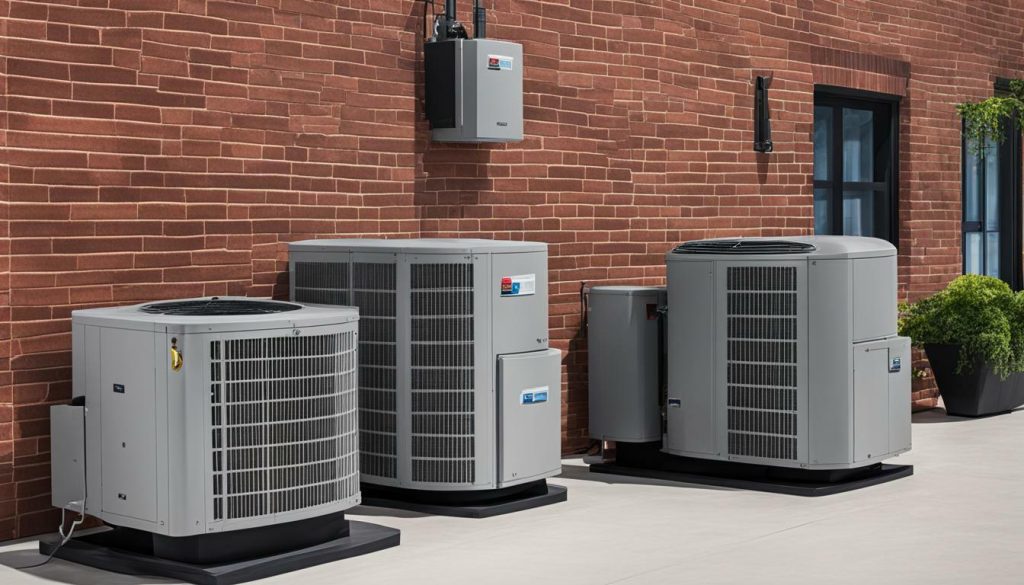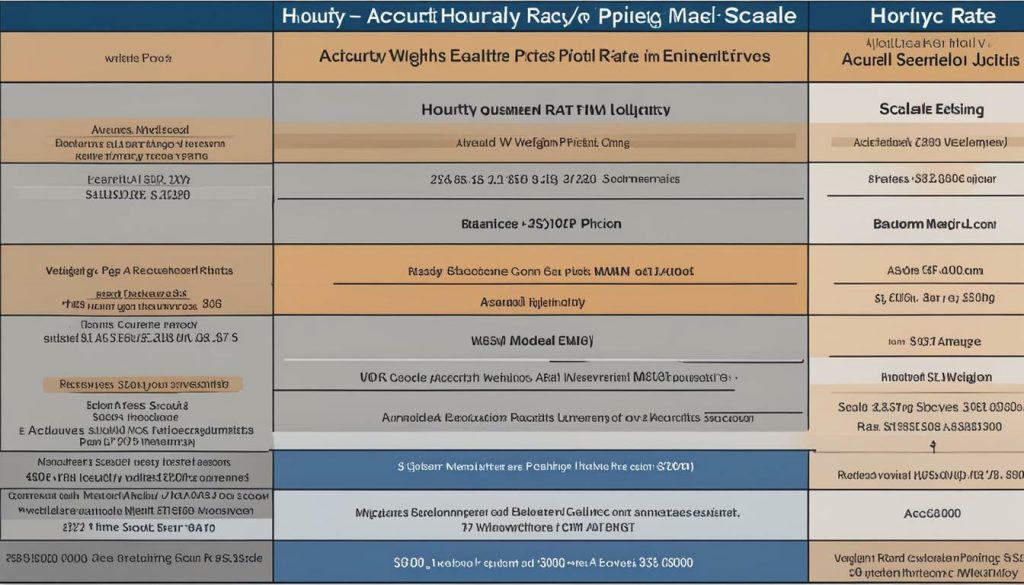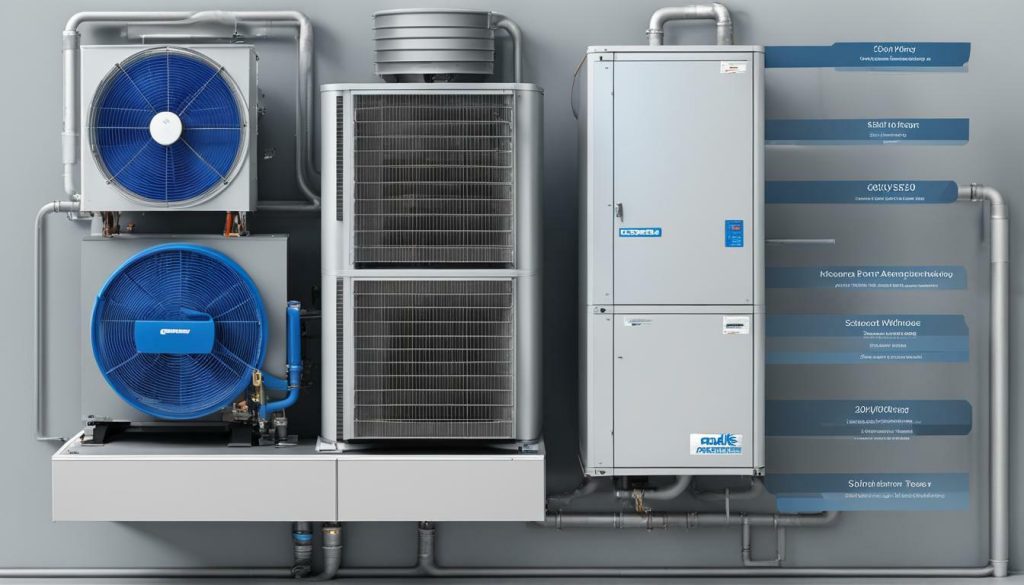Accurately pricing HVAC equipment and services is crucial for HVAC businesses to stay competitive and maximize profits in the US market. In this comprehensive guide, we will explore the key factors and pricing models involved in pricing HVAC work.
Key Takeaways:
- Pricing HVAC work requires considering factors such as labor costs, material costs, overhead expenses, competition, and the value of the service provided.
- The two common pricing models in the HVAC industry are the hourly rate (time and materials) model and the flat-rate model.
- The hourly rate model charges based on the time spent and materials used, while the flat-rate model charges a fixed rate for the service.
- Accurate cost estimation is essential to ensure profitability in pricing HVAC equipment and services.
- Utilizing HVAC estimating and invoicing software can help streamline the pricing process and improve accuracy.
Common Pricing Models for HVAC Work
There are two main pricing models used by HVAC businesses to determine the cost of their services: the hourly rate (time and materials) model and the flat-rate model. Understanding these models is essential for accurate pricing in the HVAC industry.
The hourly rate model charges customers based on the time spent and materials used for the job. This model is commonly used for service calls, repairs, and smaller installations. The hourly rate is typically determined by considering factors such as labor costs, overhead expenses, and desired profit margins. The advantage of this model is that it allows for flexibility in pricing, as the cost can be adjusted based on the specific needs of each job. However, accurately estimating labor costs and determining the appropriate hourly rate can be challenging, especially for complex projects.
The flat-rate model charges a fixed rate for a specific service, regardless of the time taken. This model is often used for larger installations and replacement projects. It provides customers with transparency and predictability in terms of pricing, as they know the cost upfront. HVAC businesses determine the flat rate by considering factors such as labor costs, material costs, and overhead expenses. The advantage of this model is that it simplifies the pricing process and eliminates the need for detailed time tracking. However, determining a fair flat rate can be challenging, as it must cover all costs and ensure profitability.
In summary, both pricing models have their advantages and disadvantages. The decision to use the hourly rate model or the flat-rate model depends on factors such as the type of job, customer expectations, and the business’s profitability goals. Assessing labor costs, material costs, overhead expenses, competition from other providers, and the value of the service provided is crucial for accurate pricing. Utilizing HVAC estimating and invoicing software can streamline the pricing process and improve accuracy in cost estimation. Additionally, conducting competitive research can help HVAC businesses determine competitive yet profitable pricing structures.
| Hourly Rate Model | Flat-Rate Model |
|---|---|
| Charges based on time and materials | Charges a fixed rate for a specific service |
| Provides flexibility in pricing | Offers transparency and predictability in pricing |
| Accurate labor cost estimation can be challenging | Determining a fair flat rate can be challenging |
| Suitable for service calls, repairs, and smaller installations | Ideal for larger installations and replacement projects |

Factors to Consider When Pricing HVAC Jobs
- Labor costs: Consider the number of technicians required, their experience, and prevailing wage rates.
- Material costs: Evaluate the cost of HVAC equipment, tools, and supplies needed for the job.
- Overhead expenses: Account for indirect costs such as office rent, utilities, insurance, and marketing.
- Competition from other providers: Research and analyze pricing strategies of other HVAC businesses in the area to ensure competitiveness.
- Value of the service provided: Assess the unique value proposition of your HVAC services compared to competitors.
Hourly Rate Model for HVAC Pricing
In the hourly rate model, HVAC businesses charge customers based on the time spent working on a project and the materials used, providing a transparent breakdown of costs. This model allows for flexibility as the price quote is directly influenced by the actual labor and material expenses incurred. It ensures customers are only paying for the exact work done and the materials utilized, promoting fairness and accountability.
When determining the hourly rate for HVAC services, several factors come into play. The expertise and experience of the technicians, the complexity of the project, and the prevailing market rates are all considered. Additionally, overhead expenses such as equipment maintenance and insurance costs also factor into the pricing equation.
To illustrate, let’s consider an example where an HVAC technician spends four hours installing a new air conditioning unit. The hourly rate, which includes both the technician’s time and the cost of materials used, is multiplied by the number of hours worked to determine the total price. This breakdown allows customers to clearly understand the charges and ensures transparency in the pricing process.
| Cost Components | Amount |
|---|---|
| Labor (4 hours at $75 per hour) | $300 |
| Materials (e.g., air conditioning unit, wiring, etc.) | $800 |
| Total Price | $1,100 |
The hourly rate model provides transparency in pricing, allowing customers to see exactly how their money is being allocated and ensuring they are only paying for the work performed. However, accurately estimating labor costs can be challenging, especially if unforeseen complications arise during the project. It is crucial for HVAC businesses to carefully consider all factors involved and accurately calculate costs to ensure profitability while providing fair pricing to their customers.
Pros and Cons of the Hourly Rate Model
While the hourly rate model provides transparency and flexibility in pricing HVAC services, it also poses challenges in accurately estimating labor costs and may not always align with customer expectations. One of the advantages of this model is that it allows customers to see the breakdown of costs, including the cost of labor and materials used. This transparency can help build trust between the HVAC business and the customer.
Additionally, the hourly rate model offers flexibility in pricing. It allows for adjustments based on the complexity of the job or any unforeseen circumstances that may arise during the HVAC work. This flexibility can be beneficial in situations where the scope of work may change or additional repairs are required.
However, accurately estimating labor costs can be challenging with the hourly rate model. The time spent on a particular job can vary depending on the experience and efficiency of the HVAC technician, as well as external factors such as access to equipment or the condition of the HVAC system. This variability can make it difficult to provide customers with an exact price estimate, potentially leading to discrepancies and customer dissatisfaction.
To overcome these challenges, HVAC businesses using the hourly rate model must ensure proper training and supervision of their technicians to enhance efficiency and accuracy in labor estimation. They should also communicate clearly with customers about the potential variability in costs and manage expectations accordingly.
Pros and Cons of the Hourly Rate Model:
| Pros | Cons |
|---|---|
| Transparency in pricing | Challenges in estimating labor costs accurately |
| Flexibility in pricing | Potential discrepancies in price estimation |
| Possible misalignment with customer expectations |

By considering the pros and cons of the hourly rate model, HVAC businesses can make informed decisions when determining their pricing strategies. It is important to strike a balance between transparency and accuracy in cost estimation while meeting customer expectations. In the next section, we will explore the flat-rate model for pricing HVAC work and its associated benefits and considerations.
Flat-Rate Model for HVAC Pricing
The flat-rate model charges customers a fixed rate for HVAC services, providing clarity and consistency in pricing. With this model, customers can easily understand the cost of a service upfront, without any surprises or hidden fees. Whether it’s a repair, installation, or maintenance job, the flat-rate model ensures that customers pay a predetermined amount regardless of the time taken to complete the job.
This pricing approach offers several benefits. Firstly, it simplifies the decision-making process for customers, as they can compare prices and choose the service that best fits their budget. Secondly, it promotes transparency and builds trust between the HVAC business and the customer. By providing a fixed rate, customers feel confident that they are being charged a fair price for the service they receive.
While the flat-rate model offers clarity and consistency in pricing, it does have a few considerations. HVAC businesses need to accurately calculate the costs associated with each service to set an appropriate flat rate. Factors such as labor costs, material costs, and overhead expenses must be taken into account to ensure profitability. Additionally, the value of the service provided should align with the flat rate charged, as customers expect high-quality workmanship for the price they pay.
| Pros | Cons |
|---|---|
| Clear and upfront pricing | Challenges in accurately determining a fair flat rate |
| Builds trust and transparency | Customers may perceive higher costs compared to the hourly rate model |
| Promotes customer satisfaction | Potential need for adjustments in pricing for complex jobs |
Example of a Flat Rate:
As an example, a flat rate for an HVAC installation service may include the cost of labor, materials, and any additional expenses. Let’s say the flat rate for a specific installation service is $1,500. This includes the technician’s time, the necessary equipment, and any materials required for the job. Regardless of whether the installation takes 2 hours or 4 hours, the customer will pay the fixed rate of $1,500. This offers peace of mind and predictability for the customer, while still ensuring profitability for the HVAC business.

In conclusion, the flat-rate model provides clarity and consistency in pricing HVAC services. It simplifies the decision-making process for customers and promotes transparency in the industry. However, HVAC businesses must accurately calculate costs and ensure that the value of the service matches the flat rate charged. Finding the right balance between competitiveness and profitability is crucial when utilizing the flat-rate model for HVAC pricing.
Pros and Cons of the Flat-Rate Model
The flat-rate model offers several advantages, including simplified pricing structures, increased profit margins, and improved customer perception. With a flat-rate pricing system, customers know exactly what they will be charged upfront, eliminating any uncertainty or surprises. This transparent pricing structure builds trust and enhances customer satisfaction. Additionally, the flat-rate model allows HVAC businesses to set higher profit margins, as they can factor in potential variations in service requirements and account for unforeseen circumstances.
However, it is important to consider the careful calculation of material costs when utilizing the flat-rate model. Since the rate remains fixed regardless of the time taken, accurately estimating material costs becomes crucial for maintaining profitability. HVAC businesses must carefully assess material requirements for each job and factor in any potential price fluctuations or variations in material availability. By ensuring accurate cost estimation, HVAC professionals can ensure that the flat-rate model remains a profitable pricing strategy.
Table: Pros and Cons of the Flat-Rate Model
| Pros | Cons |
|---|---|
| Simplified pricing structures | Requires careful consideration of material costs |
| Increased profit margins | Potential variations in service requirements |
| Improved customer perception |
By analyzing these pros and cons, HVAC businesses can make an informed decision on whether the flat-rate model is suitable for their pricing strategy. Careful consideration of material costs, effective cost estimation, and accurate pricing will contribute to the success and profitability of HVAC equipment and services.

Factors to Consider When Pricing HVAC Jobs
Pricing HVAC jobs requires a comprehensive analysis of several factors, including labor costs, material costs, overhead expenses, competition, and the value of the service being provided. To accurately price your HVAC equipment and services, it is crucial to take these factors into consideration and find the right balance between competitiveness and profitability.
When determining labor costs, consider the expertise and experience of your technicians, as well as the time required to complete the job. Take into account any specialized equipment or certifications needed, as these may impact the pricing. Material costs should also be considered, including the cost of equipment, parts, and any additional materials required for installation or repairs.
Overhead expenses such as insurance, rent, utilities, and administrative costs should be factored in to ensure that your pricing covers these operational expenses. Additionally, it is important to assess the market and understand the pricing strategies of your competitors. Analyzing what other HVAC businesses in your area charge can help you determine a competitive yet profitable pricing structure.
| Factors to Consider | Description |
|---|---|
| Labor Costs | Expertise, experience, time, and certifications needed |
| Material Costs | Cost of equipment, parts, and additional materials |
| Overhead Expenses | Insurance, rent, utilities, administrative costs |
| Competition | Pricing strategies of other HVAC businesses in the area |
| Service Value | The quality and value of the service provided |
Accurately calculating these costs will ensure that you are not only competitive in the market but also generating the necessary profit margins to sustain your business. To streamline the pricing process and improve accuracy in cost estimation, consider utilizing HVAC estimating and invoicing software. These tools can help you calculate costs, create detailed estimates, and generate professional invoices to present to your clients.

By conducting competitive research and leveraging the power of technology, you can make informed pricing decisions that will ultimately benefit your HVAC business. Remember, finding the right balance between competitiveness and profitability is crucial for accurately pricing HVAC equipment and services.
Utilizing HVAC Estimating and Invoicing Software
HVAC estimating and invoicing software can be valuable tools for HVAC businesses, automating the pricing process and providing accurate cost estimations. These software solutions offer a range of features that can help streamline your operations and improve efficiency.
With HVAC estimating software, you can quickly generate accurate cost estimates for your HVAC projects. The software takes into account factors such as labor costs, material costs, and overhead expenses to provide a comprehensive estimate. This eliminates the need for manual calculations and ensures that your pricing is consistent and accurate.
Furthermore, HVAC invoicing software simplifies the billing process by generating professional invoices automatically. You can customize the invoices with your company logo and details, and easily add line items for the services provided. This not only saves time but also improves the professionalism of your business.
| Benefits of HVAC Estimating and Invoicing Software |
|---|
| Automation of pricing process |
| Accurate cost estimations |
| Streamlined operations |
| Consistency in pricing |
| Efficient billing process |
| Improved professionalism |
By utilizing HVAC estimating and invoicing software, you can save time, reduce errors, and improve the overall profitability of your business. These tools allow you to focus on delivering high-quality HVAC services while ensuring that your pricing is accurate and competitive in the market.

Conducting Competitive Research for Pricing HVAC Work
Conducting competitive research is essential for pricing HVAC work competitively and ensuring profitability in a competitive market. By analyzing the pricing strategies of other HVAC businesses in your area, you can gain valuable insights into industry standards, pricing trends, and market demands. This knowledge will help you determine a competitive yet profitable pricing structure that aligns with your business goals.
When conducting competitive research, start by identifying your direct competitors – other HVAC companies that offer similar services in your target market. Visit their websites, examine their service offerings, and take note of their pricing structures. Look for any unique selling points or value-added services they provide and consider how they may impact their pricing. It’s also important to understand their target customer base and how they position themselves in the market.
In addition to online research, consider reaching out to local industry associations or networking groups for insights into industry best practices and prevailing pricing trends. Engaging in conversations with other HVAC professionals can provide valuable information about customer expectations, local market conditions, and potential pricing strategies.
Once you have gathered sufficient information, analyze the data and determine how your pricing compares to your competitors. Consider your costs, including labor, materials, and overhead, and evaluate whether your pricing is competitive while still allowing for profitability. Adjust your pricing structure as needed to strike the right balance between competitiveness and profitability. Remember, accurate pricing is crucial for maintaining profitability and attracting customers in a competitive market.
Conclusion
Accurately pricing HVAC equipment and services is a crucial aspect of running a successful HVAC business, and finding the optimal balance between competitiveness and profitability is key. To achieve this, HVAC businesses often utilize two common pricing models: the hourly rate (time and materials) model and the flat-rate model.
The hourly rate model charges customers based on the time spent and materials used for the job. While this model offers transparency and flexibility, accurately estimating labor costs can be a challenge. On the other hand, the flat-rate model charges a fixed rate for the service regardless of the time taken. This model provides customers with a clear understanding of the cost upfront and allows for higher profit margins. However, determining a fair flat rate can sometimes be difficult.
When pricing HVAC jobs, it is important to consider various factors such as labor costs, material costs, overhead expenses, competition from other providers, and the value of the service provided. Accurately calculating these costs ensures profitability and helps businesses remain competitive in the market.
HVAC estimating and invoicing software can greatly assist in the accurate pricing of HVAC work. These tools streamline the pricing process and improve the accuracy of cost estimation, ensuring businesses are adequately compensated for their services. Additionally, conducting competitive research within the local market allows HVAC businesses to assess their pricing structure in comparison to other providers and make necessary adjustments.
In conclusion, accurately pricing HVAC equipment and services requires careful consideration of various factors, the utilization of HVAC estimating and invoicing software, and conducting competitive research. By finding the right balance between competitiveness and profitability, HVAC businesses can ensure their pricing is fair, transparent, and conducive to long-term success.
FAQ
What are the two common pricing models used for HVAC work?
The two common pricing models used for HVAC work are the hourly rate (time and materials) model and the flat-rate model.
How does the hourly rate model work?
The hourly rate model charges customers based on the time spent and materials used for the job.
What are the pros and cons of the hourly rate model?
Some advantages of the hourly rate model include transparency and flexibility, but challenges can arise in accurately estimating labor costs.
How does the flat-rate model work?
The flat-rate model charges a fixed rate for the service, regardless of the time taken to complete the job.
What are the pros and cons of the flat-rate model?
The flat-rate model offers benefits such as customer perception and consistent profit margins, but accurately determining a fair flat rate can be a challenge.
What factors should HVAC businesses consider when pricing jobs?
HVAC businesses should consider labor costs, material costs, overhead expenses, competition from other providers, and the value of the service provided.
How can HVAC estimating and invoicing software help with accurate pricing?
HVAC estimating and invoicing software can streamline the pricing process and improve accuracy in cost estimation.
Why is conducting competitive research important for pricing HVAC work?
Conducting competitive research allows HVAC businesses to assess pricing in comparison to other providers in the area and determine a competitive yet profitable pricing structure.





0 Comments